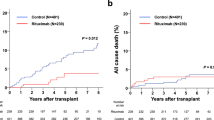Abstract
An accelerated atherosclerosis may occur in the native arteries of a transplant recipient as well as in arteries of transplanted kidneys or hearts. The dominating cause of patient mortality are cardiovascular diseases, where ischaemic heart disease is predominant. The accelerated form of arteriosclerosis which takes place in transplanted kidneys and hearts, has a complex pathogenesis, which includes both immunological and non-immunological factors. Hypertension is one such factor which has been claimed to be an independent risk factor of chronic renal transplant dysfunction, usually characterised by transplant arteriosclerosis. Whether a more intense treatment of hypertension or a more selective use of antihypertensive drugs would have a beneficial effect upon the progression rate of chronic rejection is still an open question.
This is a preview of subscription content, access via your institution
Access options
Subscribe to this journal
Receive 12 digital issues and online access to articles
$119.00 per year
only $9.92 per issue
Buy this article
- Purchase on Springer Link
- Instant access to full article PDF
Prices may be subject to local taxes which are calculated during checkout
Similar content being viewed by others
Author information
Authors and Affiliations
Rights and permissions
About this article
Cite this article
Fellström, B., Backman, U., Larsson, E. et al. Accelerated atherosclerosis in the transplant recipient: role of hypertension. J Hum Hypertens 12, 851–854 (1998). https://doi.org/10.1038/sj.jhh.1000712
Published:
Issue Date:
DOI: https://doi.org/10.1038/sj.jhh.1000712



